Jeanne Vicerial
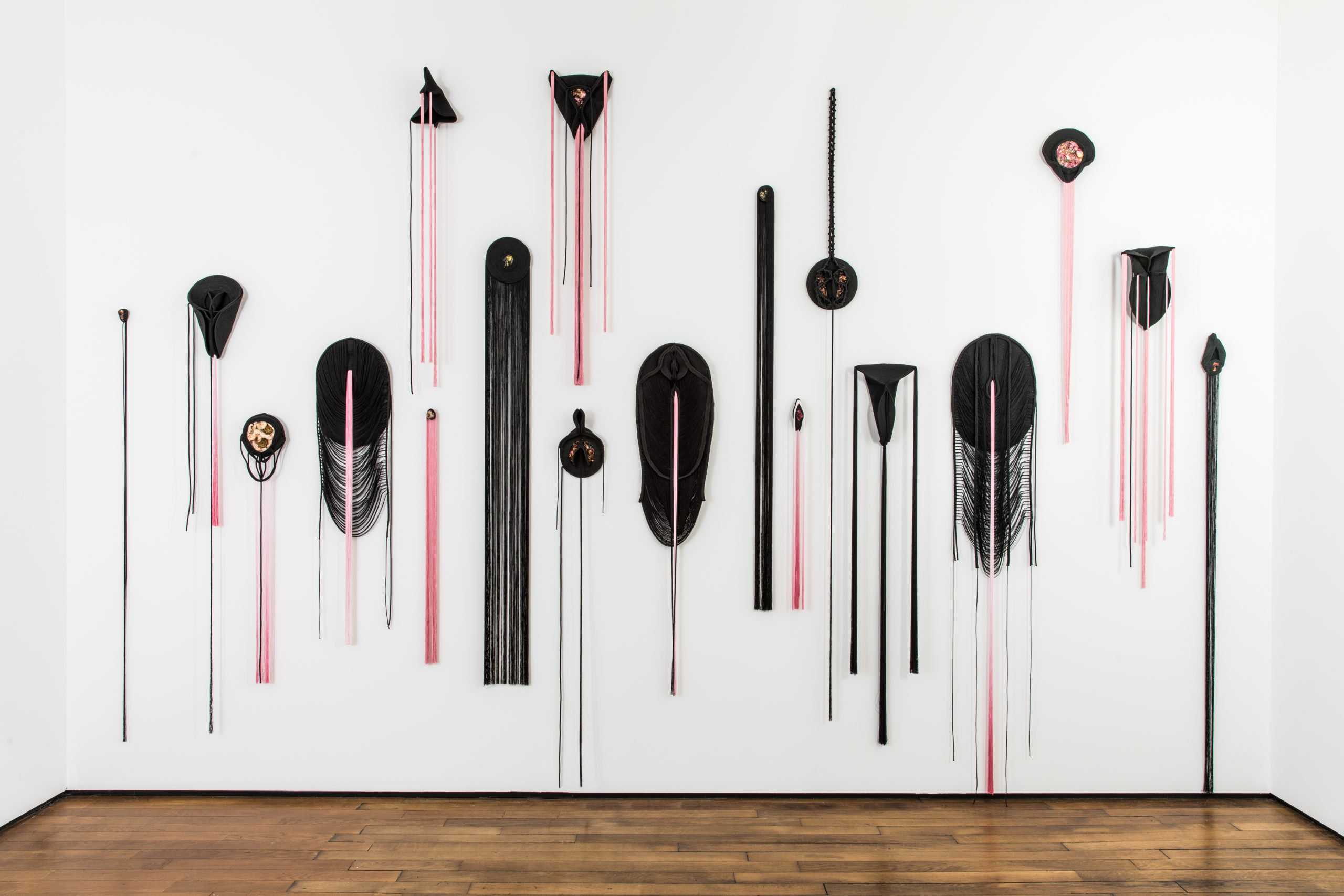
Between robotics and craft, death and creation, presence and absence, outside and inside, strength and vulnerability, stasis and movement, past and future…the works of Jeanne Vicerial break down the binaries established by western culture, mixing up the connections between one another, in order to give way to new hybrid bodies.
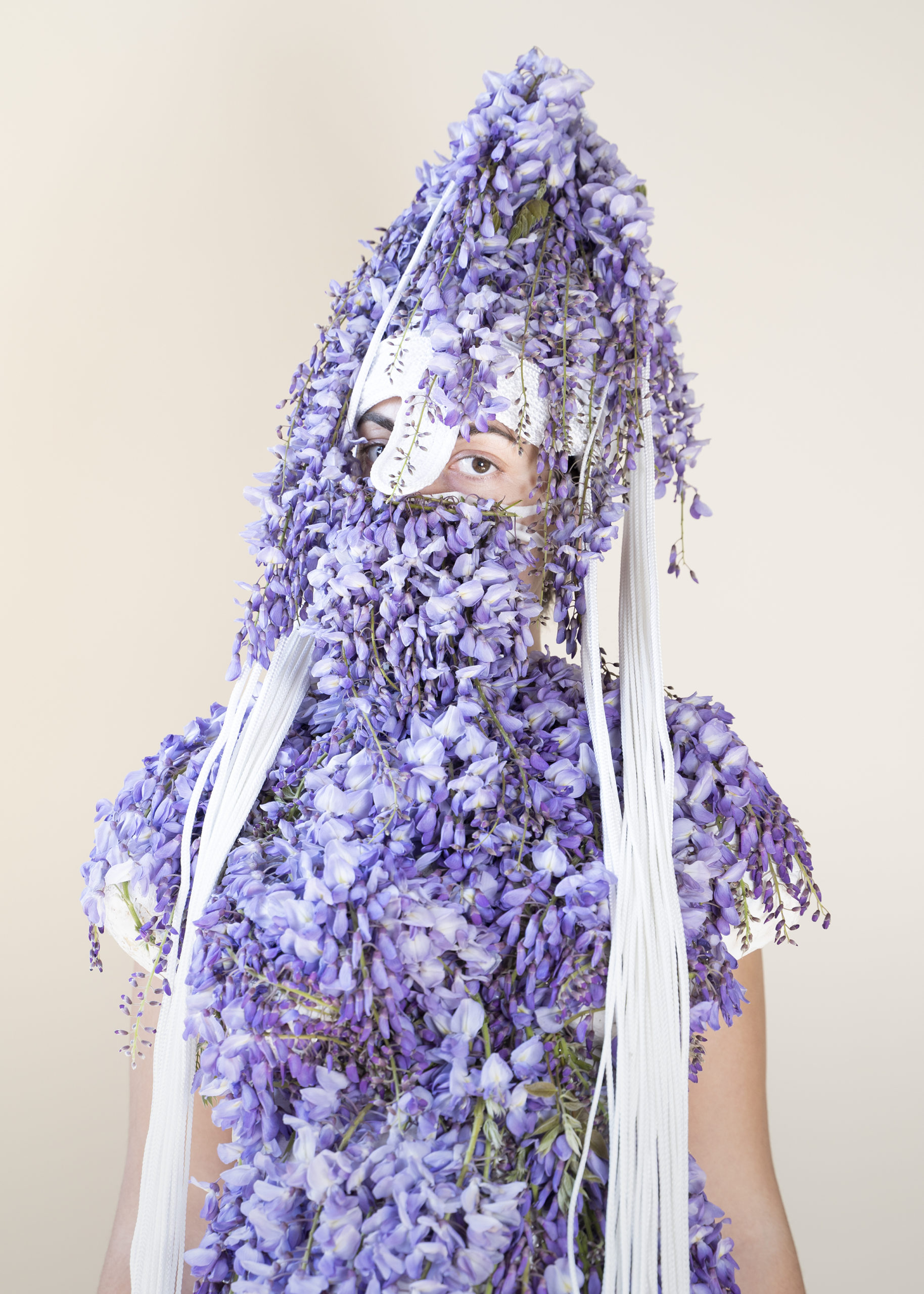
Crédits: © Jeanne Vicerial & Leslie Moquin © ADAGP, Paris, 2023
Knit-Weaving
Jeanne Vicerial develops a polymorphous practice which combines design, artisanal practices, fashion and fine arts. The artist cultivates this heterogeneity by collaborating with a diverse group of professionals from the worlds of photography (Leslie Moquin), performance (Julia Cima), music (Nadine Schütz), perfumery (Nicolas Beaulieu), and performing arts (including the production of costumes for choreographers, theatre or opera directors such as Angelin Preljocaj or Hervé Robbe). The artist’s costume and textile design training has led her to investigate the relationship between the body and an article of clothing, as well as the way the body is perceived in the fashion industry, which is a theme that she also integrates into her artworks. Her creations are textile sculptures which look like fashion collections, whose exhibition takes the form of a static runway show, allowing the public to take over on the catwalk.
These collections are neither sown nor made of cloth; Jeanne Vicerial works exclusively with string and rope. Each piece is therefore made through the weaving of a single thread—several kilometres long—which has been recovered from unused reels from the textile industry, which she then uses to draw three-dimensional garment sculptures. The artist begins with a drawing, which will determine the diameter of the monofilament which varies depending on the differing thicknesses of the black pencil lead used in the sketch. Among the techniques used are weaving, crochet, macramé, lace, knotting techniques, however the artist primarily uses a technique she invented—tricotissage, orknit-weaving. Inspired by the weave pattern found in the muscular tissues of the human body, this approach transposes anatomical drawings into textile creations. Jeanne Vicerial therefore uses thread to follow the lines of the human muscular system according to images from anatomical drawings and dissection illustrations in order to produce biomimetic garments which evoke anatomical machines of the 18th century which she refers to as “radiographies portatives” or Wearable X-rays.
Each piece requires between 200 and 1,200 hours of work. In order to modulate this relationship with time and also to develop this technique which she refers to as “prêt-à-mesure”, or ready-to-order (between made-to-order and ready-to-wear) in her doctoral thesis, Jeanne Vicerial took out a patent, along with the department of mechatronics at the MINES ParisTech school, for a robotic arm which facilitates the production of made-to-order garments, without producing waste and which are locally produced. In this way, the artist showed how robotics and manual artisanal techniques are more closely related than one may have imagined: like the work of the artist, that of the robot weaver is evolving (it is in its third incarnation at the moment). Like the artist, the robot draws in space using one individual thread, imitating the pattern of human muscular tissues.
It knit-weaves, then, using as a basis a material which comes from the inside of our own bodies with their muscles which are weaved together, underneath the skin, just like the garments which cover it. And so it would seem as if by some osmotic game of surfaces, the material from one side of the epidermis could pass over to the other side and also inversely. Muscle and textile therefore begin to resemble one another via epidermal contact. Jeanne Vicerial’s discourse treats garments as a new skin for sculptures which make material and skin coincide. Her works unveil the ambiguity between the inside and outside of the body, between its necessary presence in order for the garment to be made and its absence once the garment has taken its place. Flaying or dissecting, are for the artist, techniques which allow the equivalences to be shown between the inside and the outside. To turn one’s skin inside out therefore means allowing one’s fragilities to come to a surface which needs armour and love, in order to make new bodies and weave a new collective. This is how “Armours” came into being.
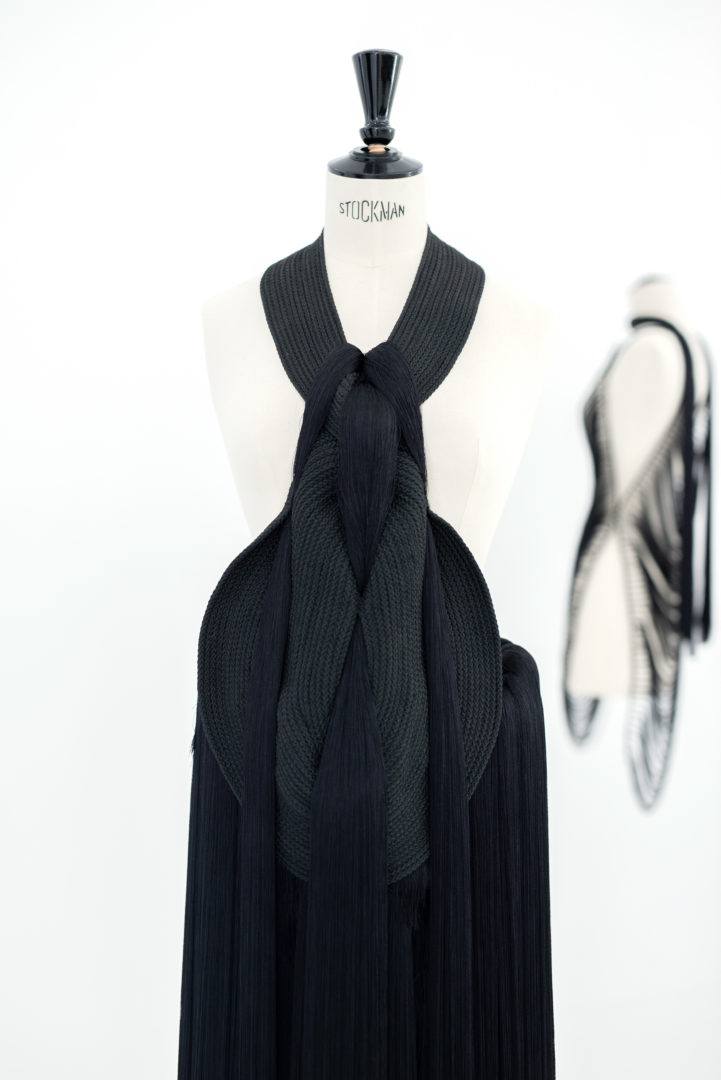
Crédits: Photo © Louise Quignon
© Collection Yvon Lambert en Avignon © Jeanne Vicerial
© ADAGP, Paris, 2023
Armours
The work of Jeanne Vicerial references mythological stories which feature feminine characters and weaving. There is the figure of Penelope, for instance, with her patient repetition of a gesture, cooperating with her assistant-slaves who weave together and with her, in her studio. How to not read Vicerial’s use of the monofilament for her sculptures through the lens of Ariadne’s legendary thread? In addition, in the film “Une Re-naissance”, or “A Re-naissance”, by Louise Ernandez, which was made for the artist’s exhibition at the basilica of Saint Denis, there are direct references to the Parcae and the Moires, who weave the thread of life, death and human destiny. The myth of Arachne is nonetheless the most representative of Jeanne Vicerial’s practice.
Arachne’s hubris refers not only to the toppling of technical hierarchies (the undisputed primacy of Athena in the art of weaving), but also to the questioning of social and cosmogony-related hierarchies, because in the competition the goddess, she creates a work which reveals the obscenities and brutality of rape and other types of violence perpetuated by the Olympian gods against women. Arachne accuses and denounces through the art of weaving, by showing the celestia crimina of divine violence and the acts of violence perpetuated by men in general. Jeanne Vicerial also accuses and denounces the crimes of history and of heteronormative patriarchal domination. She decries the macho point of view toward gender, which oscillates between fetichization and sacralisation, veneration and mistreatment. She decries the fashion industry, the ecological devastation of fast fashion and the capitalist exploitation of bodies by the garment industry in the global South. In addition, she denounces the image of the female body put forth by the textile industry, and the consequent modifications visited on the body by aesthetic surgery which treats skin like fabric. In addition, like Arachne, who is transformed into a spider after soliciting the ire of Athena and makes her body into a weapon, Jeanne Vicerial creates extensions of her body, “Armours”, which form an army adorned only with shields and whose principal weapon is therefore constituted by their own bodily presence.
In contrast with the garment sculptures, the “Armours” are not wearable. The artist says that “it is as if the sewing mannequin has been eaten by the dress,” through a type of introjection which once again, references the Arachne myth and the swallowing of the organs deep into her belly. Some of these organic armours are fashioned and refashioned by “organ garments”: interchangeable modules which allow the sculptures to be reconfigured differently. The modular approach therefore makes sculptural metamorphoses possible. Transformable and modifiable, the anatomical armours explore the ability the epidermis has to react to wounds. Bruises, blisters and calluses are indeed reactions on the part of the skin’s defense system which here, become transposed into cocoon garments which protect certain parts of the body. This brings us to the realisation that the chainmail of “Armours” are not meant for battle, but for defense. They are a form of protection for fragile skin, for marginalised, forgotten bodies, which come back to life in order to expose their sewn and sutured scars, their versions of the history of femininity. They rise up and stand tall in order to tell a counter-narrative of bodies with no name, in order to reaffirm the strength of that which has been erased from their memories, in order to retrace the history of a struggle which has been ongoing for some time, one which has left behind wounds which continue bleeding.
These protective entities, or guardians, each watch over the subterranean world (“Gisantes”, or “Effigies”), metamorphosis (“Mues”, or “Moultings”), over creation (“Amnios” or “Amnions”, spirituality (“Puppa”) and over memory (“Presences”). They do not operate along the lines of the patriarchal dynamic of the heroic gesture which leads to victory in battle, nor do they respond to a call for eventful action, but rather to the dimension of collective care. They provide protection and require care at the same time, because they must be brushed, perfumed and dressed. Made out of one single thread, they are extremely delicate and fragile. And yet, their totemic and impersonal presence cause these entities to become extremely powerful. Divinities, spirits, shadows, dreamlike images…their figures resonate with the powers of the Medusa, Cleopatra, Athena, of the High Priestess of the Marseille tarot, the kores of ancient Greece, the Women in White or the Black Virgins. Strange indeed, but also familiar, because they emerge from the atavistic process of weaving which the artist knowingly crosses with various influences, from Japanese armour to Spanish headdresses and even traditional Russian dress.
For Jeanne Vicerial, the study of the history of garments and their relationship with bodies cannot be conducted without questioning the disappearance of bodies themselves. To begin with, she inquires as to their disappearance in the context of the fashion industry, by the substitution of real bodies with the static, idealised abstract notion of standard sizes, which correspond to stereotypical images. This disappearance also references our relationship with death and everything that must eventually die. The death of the body, its absence, is therefore central to this topic which positions the garment as both that which survives a death and that which makes constant reference to its possibility. It is a memento mori which reminds us of all of the small deaths which are part of each change and each metamorphosis.
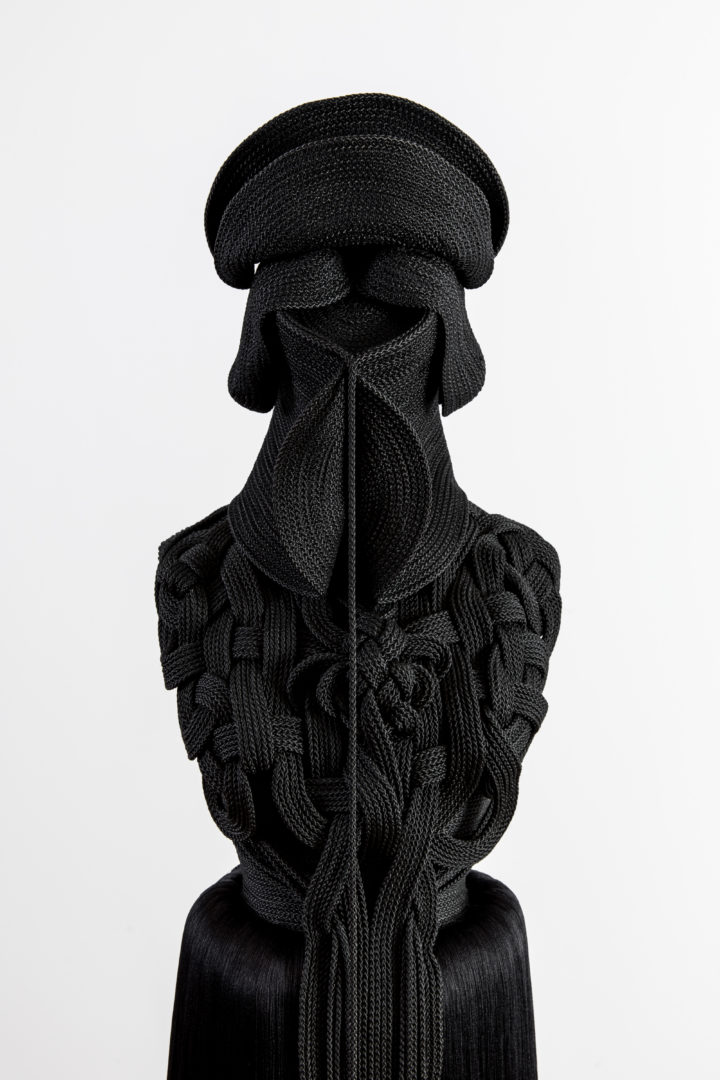
Ropes, threads – handmade
184 x 38 x 27 cm – 72.44 x 15 x 10.6 in.
Crédits : Vue de l’exposition personnelle de Jeanne Vicerial : «ARMORS», 7 janvier – 11 mars 2023, Galerie Templon, Paris.
Courtesy de l’artiste et TEMPLON, Paris – Bruxelles – New York.
© ADAGP, Paris, 2023.
Photo © Adrien Millot.
Metamorphoses
If the black of the sculptural garments of Jeanne Vicerial is a substitution for the markings of a pencil, the colour white references the marble sculptures of women and divinities that the artist dressed during her residency at the French Academy in Rome. White also references the shedding, exuviae and chrysalises of insects metamorphosing. Transformations and changes are indeed central in the universe of Jeanne Vicerial, as well as the crossover between the human, plant and animal kingdoms. There are also the pink threads and the flowers, which are the only colourful elements in her works. Pink is the colour of blood and of fluids, which are coloured by the flowers, poured from within the inside of bodies, and which circulate in their cavities. These flowers recall the myths and stories of plant metamorphoses, like those of Daphne transformed into laurel, of Clytie, who became a sunflower, and Acantha, who became a thorny plant.
During the first lockdown in 2020 in France while on a residency at the Villa Medici, the artist picked and gathered flowers in order to create one garment composition each day, during 40 days. This “quarantaine vestimentaire”, or “garment quarantine”, the photographs of which were shown in an exhibition at the Fondation Thalie in Arles (3rd July-16th September, 2023), was made as a fashion Spring-Summer season collection. The daughters of Covid, these images are directly related to death, but also to rebirth and the power of creation.
The artist dried the flowers used in this project to include them in works which are about change and the metamorphosis of the body—childbirth, pregnancy and abortion, as well as gender transitions or non-binary type transitions. In order to sketch out these changing identities which are in constant flux, Jeanne Vicerial addresses orifices, organs and viscera, by creating openings in the bodies of her creations. Flowered vulvae and mounds of Venus unveil that which habitually stays hidden beneath clothing or skin, by making the similarities between body and plant parts apparent. The “Sex Voto” are eroticised shields, inspired by the body parts which are present on ex-votos. Made out of a single thread and flowers, these sexual organ garments (ovaries, testicles, internal and external genital organs, mammary glands) are votive offerings to the Earth. Seamstress-surgeon armed with sewing needles, scissors and syringes, Jeanne Vicerial also performs “Dissections Vestimentaires” or “Garment Dissections” on the bodies of her “Venus Ouvertes” or “Open Venuses”. These works pay tribute to “La Venerina” by Clemente Susini, an 18th century anatomical model which shows a woman lying on her deathbed, writhing, and whose dissection shows a fetus in her womb. Jeanne Vicerial lifts up these Venuses which have been flayed not only of their skin, but of their bark, showing the life and the flowers which bloom from their bellies.
Like the other works of the artist, they arise, always seeking contact with the earth and the ground, so as never to lose touch with it. Each piece indeed has many multitudinous filaments which branch out toward the bottom, like hair, or like growing roots which anchor them to the ground. This aspect brings the works close to the plant or insect kingdom, since a rope hangs either from the head or summit of all of these sculptures, like a kind of proboscis or antenna. Praying mantises, arachnids, butterflies, with their larvae and their cocoons, all sorts of insects with their moultings-chainmail…these animals provide the basis for the metamorphic universe of the artist.
Jeanne Vicerial’s creations do not, therefore, come from another planet: they are not “astro-archeological finds”. To say this would be to alienate the powerful denunciatory claims of these sculptures. After all, they are bodies which give form to the collective strength of a new feminine hybridity (which remains irreducible to one genre or another), which is made from machines, fibres, plant matter and animals. They reference a mythological past, indeed, but in order to usher in a new era, like a prediction or a promise…the monsters are coming.
1 Boyan Manchev, « Le double obscur de Prométhée. La métamorphose et la technique », in Multitudes, n° 47, Mineure 47 : Prometheus versus Areva, texts selected by Frédéric Neyrat, Winter 2011.
2 Emanuele Coccia, « The Body-Cocoon », in Jeanne Vicerial, Armors, Paris, Galerie Templon, 2023, p. 26.
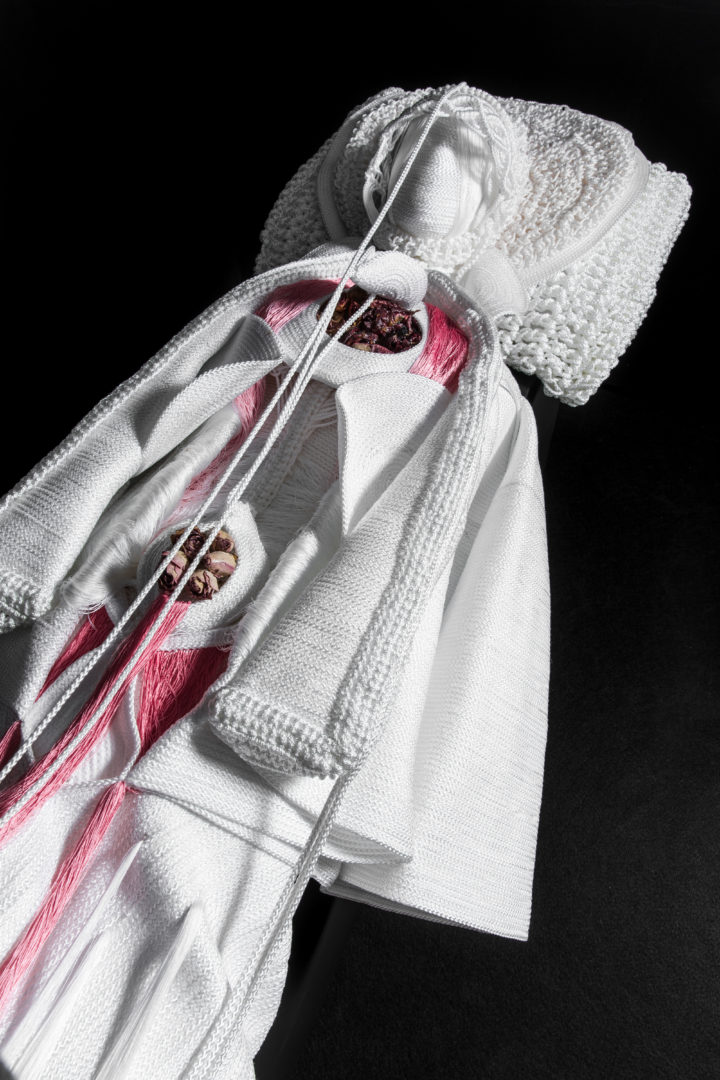
Cordes, fils, fils en dégradé, fleurs vernies (amovible) – travail à la main Ropes, threads, gradient threads, vanished flowers (removable) – handmade 231 x 60 x 50 cm
Crédits: Vue de l’exposition personnelle de Jeanne Vicerial : «ARMORS», 7 janvier – 11 mars 2023, Galerie Templon, Paris.
Courtesy de l’artiste et TEMPLON, Paris – Bruxelles – New York. © ADAGP, Paris, 2023.
Photo © Adrien Millot.
______________________________________________________________________________
Head image : Exhibition view, Jeanne Vicerial : «ARMORS», 7 janvier – 11 mars 2023, Galerie Templon, Paris.
- From the issue: 104
- Share: ,
- By the same author: Agnieszka Kurant , Tschabalala Self, Shio Kusaka,
Related articles
Iván Argote
by Patrice Joly
Laurent Proux
by Guillaume Lasserre
Diego Bianchi
by Vanessa Morisset

